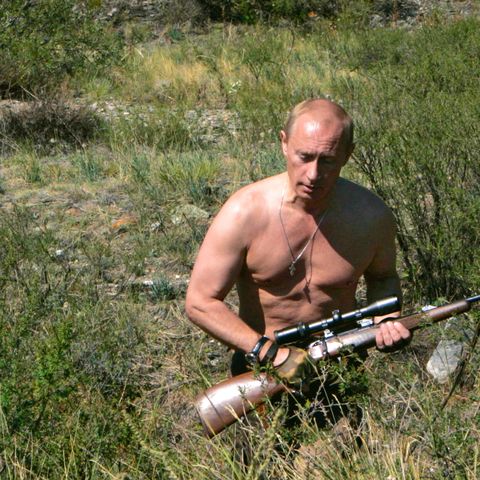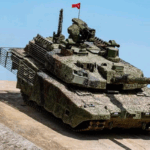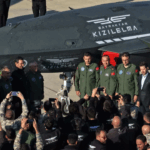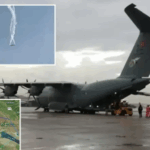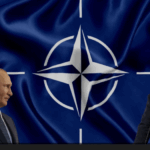Putin Is Vulnerable: Western Policy Masks Russian Weakness
Russia has vulnerabilities that the West has simply not been exploiting. On the contrary, US incrementalism has helped the Kremlin offset and mask its weaknesses. The Kremlin’s weaknesses include its inability to rapidly pivot, dependence on others for Russia’s capability to sustain the war, and years of risk accumulation that Russian President Vladimir Putin is yet to reckon with. The Kremlin is vulnerable to an adversary who can generate momentum against Russia and deny the Kremlin opportunities to regroup and adapt. A serious US strategy on Ukraine would prioritize achieving such momentum. It would include removing Western-granted safe havens for Russia’s war machine in Russia. It would also include not only imposing multiple dilemmas on the Kremlin but the most painful ones, such as helping Ukraine make Russia fail on the battlefield faster and dismantling Russian narratives in the West. While it is premature to draw conclusions about Ukraine’s offensive in Kursk Oblast, the operation clearly has the potential to generate momentum. If it does, the United States should help Ukraine build on rather than dampen this momentum to regain control over the tempo of the war.
Russia’s Vulnerability to Sustained Pressure
Russia adapts if given time. Russia does not pivot rapidly, however, in part because of Putin’s risk aversion. It took Putin months to adapt after his failed three-day invasion in 2022. He continued to pursue his maximalist objectives in Ukraine with insufficient force and ordered a mobilization only after a rout of the Russian forces from the Kharkiv region in September 2022.[1] It took Putin a year to start moving the Russian economy to a full war footing.[2] Likewise, the Kremlin has been slow to react to Ukraine’s Kursk offensive. The Kremlin waited days after the start of Ukraine’s incursion to announce a counterterrorism operation in Russia’s border regions.[3] Putin has yet to implement martial law despite repeated calls from the Russian nationalist community to do so.[4]
Putin has proven to be decisive but not extemporaneous. His boldest moves followed deliberate preparation, which the West often ignored or missed. A decade of Russian information operations in Ukraine preceded the Kremlin’s hybrid operation in eastern Ukraine in 2014.[5] Russia launched the full-scale invasion of Ukraine only after Putin re-solidified his grip on power with constitutional amendments in 2020 and normalized Russia’s military presence in Belarus in 2021, which the Kremlin had been trying to secure for years.[6] Putin has demonstrated a calculated and often risk-averse approach in his key military decisions. Putin declared a smaller, less politically costly partial mobilization in September 2022 instead of embracing the need for general mobilization. This decision ultimately led to Putin undercutting Russia’s mobilization potential.[7]
Putin faced real risks in moments when he was challenged by sustained pressure. The Ukrainian battlefield successes in the fall of 2022 led to hysteria in the Russian information space, as the military humiliation contrasted with Putin’s attempt to project an image of a ‘great Russia.’[8] The consecutive shocks of Russian withdrawal from the Kharkiv region and Kherson City drove fissures within Putin’s nationalist base and laid the foundation for the spat between the late PMC Wagner Group financier Yevgeny Prigozhin and the Russian military establishment, which eventually resulted in Prigozhin’s rebellion in 2023.[9] The shock of these defeats also led Putin to undertake notable rhetorical changes, framing Russia’s war in Ukraine as a protracted war against NATO and the West, rather than Ukraine.[10]
Had the West rushed military aid to Ukraine and planned for successive operations after the Russian defeat in the Battle of Kyiv in spring 2022 or even after Russia’s offensive culminated in Severodonetsk in summer 2022, Ukraine would be closer to a durable peace than it is today.[11]
On the contrary, Western incrementalism in the provision of military aid disrupted Ukraine’s battlefield momentum and provided Russia with a three-fold advantage: a chance for Russian forces to build their defense in depth, which monumentally complicated Ukrainian 2023 counteroffensive; a chance for the Kremlin to seize the narrative internationally; and a reduction in domestic pressures on Putin.
The United States’ incrementalism and choice to telegraph its decisions diminished the effectiveness of US policies. Delays in US decision-making afforded Russia time to develop countermeasures to US capabilities. Russia is using EW and GPS jamming to degrade the effectiveness of US ground-based long-range fires.[12] The United States’ telegraphing its internal debates about its restrictions on Ukraine’s use of US weapons gives the Kremlin time to insulate Russia from damage. Russia redeployed air assets in the range of ATACMS to airbases further away from Ukraine to protect them against a potential US policy change for Ukraine. The shock of Ukraine using new capabilities will likely have greater effects if the West stops announcing or leaking its decisions to deliver advanced capabilities to Ukraine, as the Russian military remains slow to change its posture to new threats.
Limits of Russia’s Inherent Capability
Russia depends on the will of others more than many people realize. A lot of Russia’s capability to sustain the war in Ukraine is not inherent and is, therefore, vulnerable. The Kremlin acquired some of its capabilities by force, manipulation, or by exploiting Western resources and sanctuaries. Russia depends on basing in Belarus to attack Ukraine from the north. Russia depends on foreign trade routes and intermediaries to smuggle sanctioned goods.[13] Russia depends on foreign machinery and components to produce advanced weapons.[14] Russia depends on North Korea and Iran to offset shortages in materiel.[15] Russia depends on ‘shadow fleets’ to transport its energy.[16] Russia depends on Western media to cycle its false narratives. Russia depends on continued US will to grant Russia a safe space, from which Russia can strike Ukraine with impunity — without being struck back by Ukraine with long-range US-provided systems.[17] The Kremlin depends on continued Western choice not to expel the Kremlin’s agents of influence and revenue, like Russia’s state nuclear operator Rosatom.[18]
Above all, the Kremlin depends on the West’s accepting Russia’s fabricated assertions about reality, which often cause the West to reason to conclusions that advance Russia’s interests and not ours.[19] Key examples include the false assertion that Russia has the right to a self-defined sphere of influence, and, therefore, a right to do whatever it wants to those within this sphere — including invading — with no repercussions. Another example is a false assertion that any provision of advanced military capability to Ukraine is a red line that will result in a nuclear escalation, and therefore, the US should de facto grant a veto to any nuclear power over US national security policy. Kremlin’s strategy in Ukraine disproportionately depends on the West accepting these premises, making Russia vulnerable to changes in Western perceptions. Russian dependencies give the West opportunities to exploit or dismantle Russia’s capability to sustain the war against Ukraine.
Russia cannot siphon capability from others overnight. It takes time to secure capabilities by manipulation or force and to convert partnerships into capabilities. It took Putin at least six years to force Belarus into becoming a de facto Russian military base.[20] It took months for Russia to establish joint UAV production with Iran in Tatarstan.[21] Russia is vulnerable to an adversary capable of anticipating and disrupting the Kremlin’s pivots before the Kremlin can turn them into war capability.
Russia’s partnerships require tradeoffs and are vulnerable when both partners are pressured. While the Russo–Iranian partnership is durable, its military interdependence enhances mutual capability only as long as Russia and Iran are not challenged at the same time. Russia’s loss of advanced air defense systems and air assets in Ukraine will likely limit the Kremlin’s ability to spare those systems for Iran — at a time when Iran may increasingly require them especially if the Islamic Revolutionary Guard Corps (IRGC) were to face a full-fledged Israeli-partner response to its aggression. The Kremlin’s reported message that Iran should exercise restraint when acting against Israel is therefore unsurprising.[22] The Russo–Iranian partnership is therefore vulnerable to a cohesive US strategy to counter both threats if the United States were to adopt one. Moreover, Russia’s growing intent to arm Iranian proxies, aimed at deterring Western support to Ukraine, can backfire by inviting US retaliation, were Iranian proxies to threaten US assets directly with Russian capabilities, and by further undermining the Kremlin’s ability to balance between regional stakeholders.[23]
Many of Russia’s relationships do not have a durable foundation and may crumble if ‘partners’ perceive Russia’s loss. Demonstrating that Russian victory is not inevitable will have compounding effects on Russian ability to sustain the war. China is Russia’s enabler in this war, but it has not openly provided military assistance to Russia.[24] China is behaving in a metered way likely not to heavily support a proposition that may be losing. The Kremlin is alienating even its close partners. Kremlin propagandists and officials have been threatening Armenia and Kazakhstan if either were to pivot away from Russia.[25] Armenia is distancing itself from the Russia-led Collective Security Treaty Organization (CSTO), as Russia has proven to be an unreliable partner when it failed to protect Armenia against the 2023 Azerbaijani attack.[26] Russian partnerships that are purely transactional are also at risk. Russia’s ability to provide value, such as reliable military exports, will further diminish if the West exhausts Russian capability faster.[27] Helping Russia lose faster in Ukraine will likely accelerate the process of other states distancing themselves from the Kremlin.
Russia’s Risk Accumulation
The Kremlin can absorb enormous costs but not without risk or limits. US incrementalism strengthens Putin’s ability to absorb risk, as it grants the Kremlin time to normalize an increasingly worse reality within Russia. The next 2–3 years are critical for the Kremlin in this war, however. If US support to Ukraine persists and gains momentum, the Kremlin will have to reckon with its accumulating problems.
The Kremlin is eroding Russia’s future capabilities. Materiel is a decisive capability for Russia in this war. Russia is burning through a lot of its equipment in pursuit of limited tactical gains.[28] Russia’s defense industrial base (DIB) and ‘partner’ support can likely support the Russian strategy of gradual battlefield gains in the short term. Russian DIB’s ability to consistently support Russia’s current tempo or to fully resource Russia’s reserve manpower is far from a given, however.[29] The Kremlin’s policies are eroding the foundation of Russia’s defense production, including macroeconomic stability and workforce.[30] The West, on the other hand, can surge its great latent capability in support of Ukraine.[31] The prospect of persistent US support to Ukraine that includes increasing US defense production and helping Ukraine regain battlefield initiative is a direct threat to Putin’s strategy of gradual gains. Improved defense production will also be essential to support US requirements in other theaters.
Putin’s control over Russia is strong, but it is built on fragilities and conflicting structures. For years, Putin has been cohering Russian society and his regime around those who are willing to get in line with his agenda. Putin is increasingly dependent on those who support his regime and the war (Russian nationalists), those willing to fight against Ukraine for ideological, monetary or other reason (Russia’s mobilizable force), and those willing to protect the regime (the Kremlin’s suppression apparatus). Prigozhin’s failed mutiny in 2023 and Ukraine’s Kursk offensive in 2024 exposed weaknesses of Russian domestic security.[32] Russia’s invasion of Ukraine also introduced new divides and worsened old fissures. Empowerment of xenophobic ultra-nationalists coupled with the Kremlin’s targeting of non-ethnic Russians for mobilization is exacerbating ethnic tensions in Russia.[33] Rising ultranationalism — which Putin needs to sustain the war — is ironically a direct threat to Putin’s fundamentally imperial ways of ruling Russia through his long-standing effort to portray Russia (even if falsely) as an inclusive multi-ethnic and multi-confessional federation.[34] The brutality of returning Russian soldiers, many of whom are convicted criminals, is creating tensions within Russian society with repeated incidents of violence of soldiers against civilians and even civilian violence against returning soldiers.[35]
Putin’s strategy — so far, a successful one — has been that of controlled risk accumulation. He has counted on Russia to absorb enormous costs, while Putin meticulously mitigated a few select risks related to the regime stability. For example, the Kremlin has been systemically tightening control over the information space in Russia over the years.[36] Putin is offering steep financial compensations for Russian mobilized, contract, and volunteer servicemen to ensure that Russian society remains docile to the Kremlin‘s increasing demands for sacrifices.[37] Putin’s strategy of controlled risk accumulation worked for twenty-five years in part because of Russian society’s ability to accept an increasingly worse reality. Russia normalized 500,000 Russian causalities in a war against a country that Russians used to portray as a brotherly nation. Putin has also rarely been challenged with enough pressure that would stretch his ability to manage the risks.
Putin’s risk mitigation approach may continue to work but it does require Putin to constantly manage a substantial amount of risk. This approach is vulnerable to an adversary who can create conditions that stretch Putin’s risk management capacity and deny the Kremlin time to normalize a worse reality within Russia.
Exploiting Russian Vulnerabilities: A Strategy of Persistence and Momentum
The Kremlin is cognizant of its vulnerabilities and Western opportunities to exploit them. Putin’s main effort in his war against Ukraine has been to ensure that Western policies on Ukraine never achieve persistence or momentum.[38] US policy of controlled escalation has given Putin just that: an environment where Russia is never challenged with enough velocity across time and space for the costs and risks to exceed the Kremlin’s capacity to manage them.
US persistence and momentum are key to denying Russia the ability to sustain its war against Ukraine. An effective campaign would seek to degrade, disrupt, and destroy the Kremlin’s capability and sources of capability to sustain the war in Ukraine across theaters, in multiple domains, in a way that denies the Kremlin time to adapt and reconstitute this capability. The United States should seek to help Ukraine. The United States and its partners regain control over the tempo of the war and force the Kremlin to contend with compounding pressures without easy ways to offset them. Russian capability can be brought down to its true size by stripping the Kremlin of its sanctuaries and safety nets.
Western strategy should focus not only on imposing multiple dilemmas on the Kremlin but also on imposing the most painful ones. First, Russia’s military failures are a lynchpin that makes other actions to degrade Russia’s military capability more effective. Helping Ukraine restore maneuver to the battlefield, building on momentum afforded by Ukraine’s operation in Kursk, and reinforcing the already successful efforts to demilitarize Crimea are therefore strategic, not only operational, priorities.[39] The United States can help Ukraine do so by opening all legitimate military targets within Russia for strikes with US weapons; increasing the speed and scale of capability deliveries to Ukraine; and surging US and partner defense production to sustain the momentum of capability deliveries to Ukraine. Second, Putin’s center of gravity is his ability to shape the will and decisions of the West, Ukraine, and Russia itself.[40] The US must adopt a strategy to persistently dismantle the Kremlin-generated alternative reality that helps Russia advance in the real world.
The West must abandon its reactive mentality that seeks to contain Russia through countermeasures. Countermeasures are inherently reactive. The effort to limit the Kremlin’s access to Western technologies is an example of a cat-and-mouse game, in which the West grants Russia turns to adapt its sanction-evasion techniques. The West can instead anticipate Russia’s likely pivots to pre-emptively block its moves.[41] This non-trivial effort would require the United States to proactively coordinate across theaters with partners.[42] Any war that the United States will fight or help to fight, however, will have the same requirement.
By Nataliya Bugayova
Source: Institute for the Study of War
[1] https://www.understandingwar.org/backgrounder/russian-offensive-campaign-update-february-5-2023
[2] https://www.understandingwar.org/backgrounder/russian-offensive-campaign-assessment-december-12-2023; https://www.understandingwar.org/backgrounder/russian-offensive-campaign-assessment-march-25-2023
[3] https://www.understandingwar.org/backgrounder/russian-offensive-campaign-assessment-august-10-2024
[4] https://t.me/Alekhin_Telega/11184; https://t.me/dva_majors/49300; https://www.understandingwar.org/backgrounder/russian-offensive-campaign-assessment-june-13-2023
[5] Page 20: https://www.understandingwar.org/sites/default/files/Putin%27s%20Offset%20The%20Kremlin%27s%20Geopolitical%20Adaptations%20Since%202014.pdf
[6] https://understandingwar.org/backgrounder/weakness-lethal-why-putin-invaded-ukraine-and-how-war-must-end; https://www.understandingwar.org/backgrounder/belarus-warning-update-putin-will-increase-pressure-lukashenko-integrate-belarus-2021; https://www.dw.com/en/putin-moves-to-establish-russian-military-base-in-belarus/a-18724911
[7] https://www.understandingwar.org/backgrounder/russian-offensive-campaign-update-february-5-2023
[8] https://www.understandingwar.org/backgrounder/russian-offensive-campaign-assessment-october-2; https://www.understandingwar.org/backgrounder/russian-offensive-campaign-assessment-october-9
[9] https://www.understandingwar.org/backgrounder/russian-offensive-campaign-assessment-march-12-2023; https://www.understandingwar.org/backgrounder/putin-track-disappoint-multiple-competing-factions-russia; https://www.understandingwar.org/backgrounder/russian-offensive-campaign-assessment-october-9; https://www.understandingwar.org/backgrounder/russian-offensive-campaign-assessment-october-2; https://www.understandingwar.org/backgrounder/russian-offensive-campaign-assessment-march-12-2023; https://www.understandingwar.org/backgrounder/russian-offensive-campaign-assessment-february-26-2023
[10] http://en.kremlin dot ru/events/president/news/69390
[11] https://www.understandingwar.org/backgrounder/russian-offensive-campaign-assessment-january-29-2023; https://understandingwar.org/backgrounder/kremlin%E2%80%99s-pyrrhic-victory-bakhmut-retrospective-battle-bakhmut; https://www.understandingwar.org/backgrounder/russian-offensive-campaign-assessment-june-24; https://www.understandingwar.org/backgrounder/russian-offensive-campaign-assessment-july-3; https://www.understandingwar.org/backgrounder/ukraine%E2%80%99s-sustained-counteroffensive-denying-russia%E2%80%99s-prolongation-war
[12] https://amp.cnn.com/cnn/2023/05/05/politics/russia-jamming-himars-rockets-ukraine/index.html ; https://www.defenseone.com/threats/2024/04/another-us-precision-guided-weapon-falls-prey-russian-electronic-warfare-us-says/396141/
[13] https://cepa.org/article/central-asia-a-lucrative-back-door-to-russia/; https://www.reuters.com/world/us-allies-press-uae-over-russia-trade-sanctions-2024-05-01/; https://www.csce.gov/briefings/russias-swiss-enablers-2/; https://rusi.org/explore-our-research/publications/policy-briefs/disabling-enablers-sanctions-circumvention
[14] https://c4ads.org/reports/war-machine/
[15] https://www.reuters.com/business/aerospace-defense/iran-deliver-hundreds-ballistic-missiles-russia-soon-intel-sources-say-2024-08-09/; https://www.understandingwar.org/backgrounder/russian-offensive-campaign-assessment-august-10-2024#:~:text=Reuters%2C%20citing%20multiple%20intelligence%20sources,missiles%20at%20an%20unspecified%20%E2%80%9Csoon; https://time.com/6988568/north-korea-russia-artillery-shell-south-korea-defense-minister/
[16] https://kse.ua/about-the-school/news/assessing-russia-s-shadow-fleet-initial-build-up-links-to-the-global-shadow-fleet-and-future-prospects/; https://windward.ai/knowledge-base/illuminating-russias-shadow-fleet/; https://www.bloomberg.com/news/articles/2024-07-18/europe-agrees-new-crackdown-on-russian-oil-tanker-shadow-fleet
[17] Rhttps://www.understandingwar.org/backgrounder/putins-safe-space-defeating-russias-kharkiv-operation-requires-eliminating-russias
[18] https://www.fdd.org/analysis/2023/12/06/radioactive-executives-from-russia-rosatom-sanctions/; https://foreignpolicy.com/2024/04/09/russia-rosatom-nuclear-uranium-sanctions-war-putin-ukraine/; https://www.cnn.com/2023/03/06/energy/russia-nuclear-industry-no-sanctions/index.html
[19] https://www.understandingwar.org/backgrounder/denying-russia%E2%80%99s-only-strategy-success
[20] https://www.understandingwar.org/backgrounder/belarus-warning-update-putin-will-increase-pressure-lukashenko-integrate-belarus-2021; https://www.dw.com/en/putin-moves-to-establish-russian-military-base-in-belarus/a-18724911
[21] https://www.wsj.com/world/the-russian-drone-plant-that-could-shape-the-war-in-ukraine-7abd5616; https://www.washingtonpost.com/investigations/2023/08/17/russia-iran-drone-shahed-alabuga/
[22] https://www.understandingwar.org/backgrounder/russian-offensive-campaign-assessment-august-6-2024
[23] https://www.understandingwar.org/backgrounder/russian-offensive-campaign-assessment-august-3-2024
[24] https://www.uscc.gov/research/chinas-position-russias-invasion-ukraine; https://www.atlanticcouncil.org/blogs/new-atlanticist/chinas-support-for-russia-has-been-hindering-ukraines-counteroffensive/; https://jamestown.org/program/chinese-machine-tools-serve-as-russias-safety-net/
[25] https://www.youtube.com/watch?v=D-WPJLB1PiI; https://www.facebook.com/watch/?v=733464994468179; https://www.youtube.com/shorts/-AJZ4ZPCoss; https://www.azatutyun.am/a/32847225.html
[26] https://carnegieendowment.org/russia-eurasia/politika/2024/06/armenia-leaves-russian-orbit?lang=en; https://www.understandingwar.org/backgrounder/russian-offensive-campaign-assessment-august-6-2024
[27] https://ipdefenseforum.com/2024/04/russias-arms-sales-plummet-as-india-others-seek-new-suppliers/
[28] https://www.understandingwar.org/backgrounder/russian-offensive-campaign-assessment-july-30-2024; https://www.understandingwar.org/backgrounder/russian-offensive-campaign-assessment-july-25-2024
[29] https://www.understandingwar.org/backgrounder/russian-offensive-campaign-assessment-july-14-2024; https://www.rusi.org/explore-our-research/publications/occasional-papers/methodology-degrading-arms-russian-federation
[30] https://x.com/Gerashchenko_en/status/1817974804169080986; https://x.com/warfrontline/status/1817860278467322276?s=46&t=W7WxLjYMXarKaEDlXgehNA; https://www.reuters.com/markets/rates-bonds/no-room-russia-cut-rates-this-year-inflation-climbs-economy-overheats-2024-08-02/; https://x.com/DefenceHQ/status/1792473858575937892
[31] https://www.understandingwar.org/backgrounder/denying-russia%E2%80%99s-only-strategy-success
[32] https://www.understandingwar.org/backgrounder/russian-offensive-campaign-assessment-june-24-2023; https://understandingwar.org/backgrounder/russian-offensive-campaign-assessment-august-11-2024
[33] https://understandingwar.org/backgrounder/russian-offensive-campaign-assessment-march-29-2024
[34] https://tass dot ru/politika/20377823 ; https://www dot interfax.ru/russia/948710; https://www.understandingwar.org/backgrounder/russian-offensive-campaign-assessment-june-26-2024 ; https://www.understandingwar.org/backgrounder/russian-offensive-campaign-assessment-june-26-2024
[35] https://www.newsweek.com/russia-ukraine-kremlin-veterans-violence-1927948#:~:text=But%20the%20return%20of%20prisoners,injured%20at%20least%20100%20more; https://lenta dot ru/news/2024/06/04/v-rossii-podrostki-izbili-veterana-svo-bez-nogi/ ; https://vestiprim dot ru/news/ptrnews/150341-uchastnik-svo-byl-zhestoko-izbit-vo-vladivostoke.html ; https://regnum dot ru/news/3885123
[36] https://www.understandingwar.org/backgrounder/russian-offensive-campaign-assessment-september-28-2023; https://understandingwar.org/backgrounder/russian-offensive-campaign-assessment-july-12-2024; https://www.understandingwar.org/backgrounder/russian-offensive-campaign-assessment-march-1-2023
[37] https://understandingwar.org/backgrounder/russian-offensive-campaign-assessment-july-31-2024; https://www.understandingwar.org/backgrounder/russian-offensive-campaign-assessment-november-4
[38] https://www.understandingwar.org/backgrounder/russian-offensive-campaign-assessment-february-12-2023; https://www.understandingwar.org/backgrounder/denying-russia%E2%80%99s-only-strategy-success
[39] https://www.understandingwar.org/backgrounder/ukraine-and-problem-restoring-maneuver-contemporary-war; https://www.understandingwar.org/backgrounder/russian-offensive-campaign-assessment-august-13-2024
[40] https://www.understandingwar.org/backgrounder/denying-russia%E2%80%99s-only-strategy-success
[41] https://www.rusi.org/explore-our-research/publications/occasional-papers/methodology-degrading-arms-russian-federation
[42] https://www.rusi.org/explore-our-research/publications/occasional-papers/methodology-degrading-arms-russian-federation

